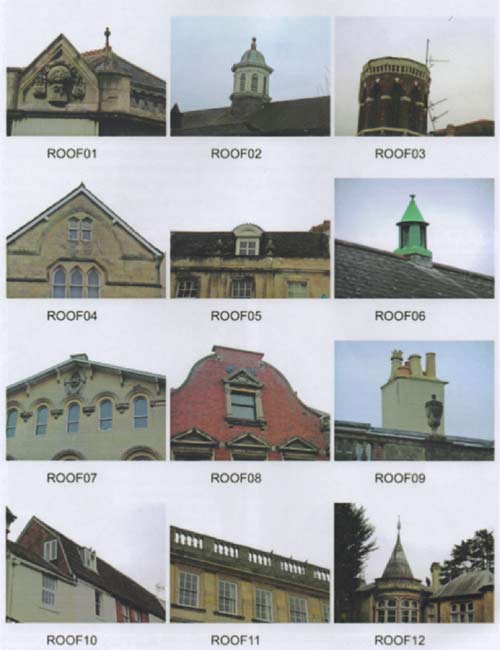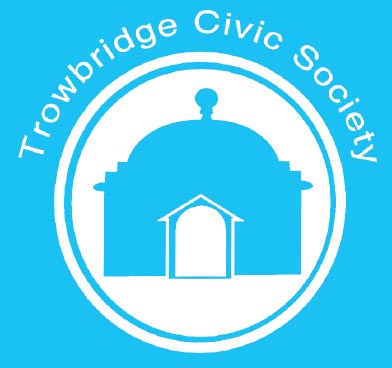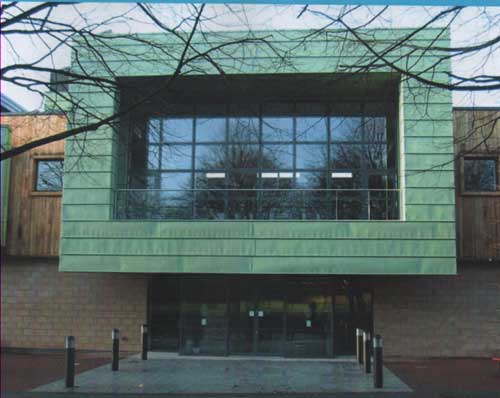| ||||||||||||||||||||||||||
Contents
Click on the item to go to the article. |
Editorial CommentWe are sorry to say goodbye to newsletters editors, John and Kay Austin, who are moving out of the area, though they still hope to attend some meetings. We are grateful for all the work they have done in making the newsletter what it is today. Deadline for copy for the summer edition is Friday 4th May. |
Forthcoming Events
| 2012 | ||
| Date and Time | Event | Venue or Meeting Point |
| Tuesday 13th March 19:15 |
Annual General Meeting and Talk - “Organised Crime, Crime Waves and Thieves in Hoodies - Crime in the Middle Ages” | Haden Room, United Church, Church Street, Trowbridge. |
To arrange for a lift or to volunteer to car share please contact Glyn on 755784
FROM THE CHAIRMAN |
Now that applications for the old Bowyer and Tesco sites are in it is hoped that the town may soon have its long awaited cinema. Whichever application receives its permission first will mean that the other applicant will have to drop the idea of a cinema complex and come up with something new. We must now await the decision of the Planning Committee.
Many favourable comments about the Newsletter have been received and we want to maintain this interest. We are always pleased to include articles from members but the editorial committee thought it might introduce a letters column in future editions as a trial to test their popularity so if you have a comment to make please write to the editor.
Obit. John Woodford.
John died on 7th January following a Long illness. John had been a committee member and was in charge of the Civic Society sales and, together with his wife Barbara, Civic Society publicity.
John also produced a very comprehensive report on street furniture.
We are gratefuL for the contribution he made in furtheiing the aims of the Civic Society.
Planning Matters |
Multi-screen digital cinema, hotel, restaurants/cafés/bars/retail and associated car parking, public realm and landscaping works, vehicular access, pedestrian and cycle links.
Former Tesco's Site, St Stephen's Place, Trowbridge
Trowbridge Civic Society has made the following comments on the above proposal:
We welcome the much-needed hotel proposal. This will provide enhanced accommodation and, through competition, will help develop further the already-existing provision in the town. The range of restaurants will potentially enhance provision in Trowbridge, although we anticipate that litter will be a problem, and this should be addressed. However, the design of the hotel seems dated, with a repetitive frontage and roofline. We feel that, since this building is in such a prominent position, greater care should be taken to make the building attractive, possibly with balconettes to break up the wall space, a pitched roof, and certainly more trees to screen the building from Mortimer Street to soften the continuous elevation. Matching the hotel more closely to the existing buildings at the corners of Castle Street and Court Street, and Castle Street and St Stephen's Place would be preferable, though, and could be subsumed with the praiseworthy intention to produce a contemporary design, rather than pastiche.
We recognise that the context makes a contemporary design appropriate, and we welcome the awareness of the need to enhance the significant town centre location. This will create a ‘critical mass’ for the centre, and WILL facilitate the creation of a new cultural hub, helping to keep this part of Trowbridge viable and alive. The quality of the materials must reflect the importance of this location, and must weather attractively. The colour of the bricks must be carefully chosen. The design of the cinema in particular is varied and attractive.
Access is important, and we are unsure as to the adequacy of parking. We welcome the specific provision for cycling, however. The continued existence of the dilapidated, unattractive Peter Black site is not addressed by this proposal, and we feel that this is to be regretted.
We are aware that there are two proposals for significant developments in Trowbridge, including two proposed cinemas. Although the proposal for the Bowyer's site seems to be of high quality architecturally, we feel that the hotel provision, and the creation of a cultural and civic ‘hub’ in a central position, tip the balance in favour of this proposal, as long as the reservations we have indicated above are addressed.
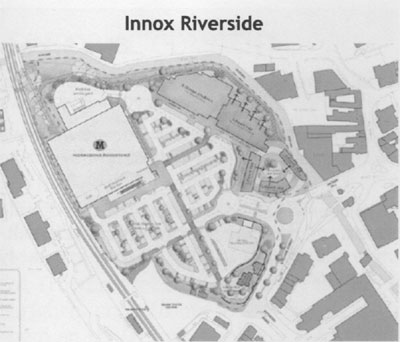 | 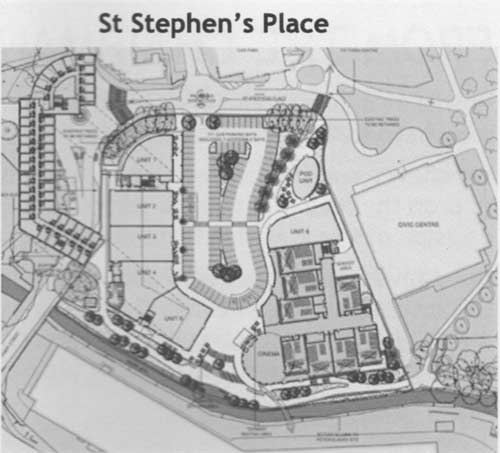 |
Innox Riverside
Proposed development of former Bowyer's Site, Stallard Street, Trowbndge
We feel that this is a good proposal. Prorsus, the developers, claim that in their developments, ‘responsive and elegant architecture is procured’. They claim also that ‘other stakeholders’ interests are property acknowledged, and the plans available seem to bear this out. There is a good awareness of the historical context, and the adverse effects are considered of earlier road developments, including the isolation of the Bowyer's site from the town centre, owing to traffic flow and the visual effect of the retaining wall erected in the 1970s. We were impressed by the developers' concern to maintain and adapt for new usage the significant buildings on the site (or their frontages) - the old mill buildings, the ashlar-faced curve of offices by the Town Bridge, and the Regency buildings which face the Street and which would be a considerable loss if demolished. We regret the proposed demolition of the two early properties by the entrance to the station at the mini-roundabout but understand the need improve access and enable landscaping.
The architectural quality of the proposed buildings seems good, and we welcome strongly the careful approach to the listed buildings on the site. Even the Morrison's supermarket seems to be of an appropriate scale, with some interest in the materials used and the organisation of the component masses within the structure. The use of brick is a pleasing feature, acknowledging the building context of Trowbridge, but the colour of that brick must be matched with the characteristic materials widespread through the town, avoiding the kind of inappropriate materials used in Sainsbury's.
Linkage to the town centre is an aspect worth reflecting on. The leisure emphasis of the site, with the supermarket, will move the centre of gravity of the town away from the present centre towards the station and Trowbridge Gateway. However, we are pleased that consideration has been given to this, with increased pedestrian usage of the town centre likely, especially with the proposed Usher's development, bringing business and life to that area, particularly at night. The proposed riverside walk and cyclepath would also help in linking the development to the town, and to the residential areas on Bradford Road.
The landscaping will need careful consideration of the paths which pedestrians will tread. Paths worn through shrubberies and flower beds in other new developments suggest that insufficient attention has been paid by planners to the natural flow of pedestrian traffic, and make any development look shabby and uncared-for. Perhaps it would be possible to replace the plantings shown on the plans with attractive paving which would stand up better to pedestrians creating their own routes through the site which may be more convenient than those originally envisaged at the planning stage. Consideration should be given, also, to some way of screening the Riverway trading estate from the path and cycleway. Having a riverside walk is fine, but if the other side of the river is an industrial site, it would seem to negate the presumed aesthetic advantages the river access would offer.
Finally, the proximity of Innox Riverside to the railway is an opportunity to encourage the use of public transport, and we support the arguments for encouraging rail usage of the site from other centres in West Wiltshire, welcoming the opportunities for rail and road integration which the site offers. However, the environmental advantages of supplying the site by rail rather than road do not appear to have been addressed, which is to be regretted.
More Planning Matters |
Construction of 3 new dwellings within the grounds of South Rodwell Hall, Victoria Road Trowbridge
The Trowbridge Civic Society has lodged an objection to this proposal. First, the proposed development is within the curtilage of a historically-significant listed building. We do not feel that precedent is a justification for the continued spoliation of such a site. Additionally, there is a safety issue with the increased traffic which would be generated, on a bend which is already a source of concern regarding safety.
First Impressions: The new Civic Centre |
The town's Civic Centre has been un-veiled at the lower end of the town park. There is now a disparate collection of buildings surrounding the park. The multi-storey car park dominates the west side, in stark contrast to the Art Deco bandstand opposite. The over-scaled Raleigh Court looms at the east end, whilst the police station flaps its gull winged canopy just outside the Polebarn Road entrance. There is perhaps nothing more eccentric than the Franco-Elizabethan old town hall at the top end of the park. The town hall and the park itself were provided by William Roger Brown in 1889. Is the new Civic Centre a suitable addition?
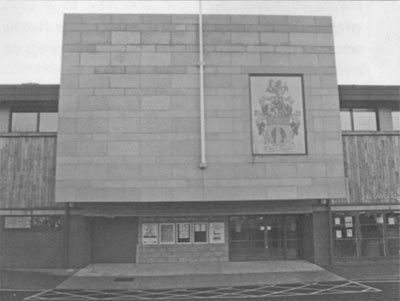 The Town Council have billed it is as the flagship conference and civic centre for Wiltshire. About 60% of the new building will be available for weddings, concerts and other forms of entertainment. These facilities were offered at the civic hall that stood on the site between 1974 and 2010. By the addition of a first floor, however, the building has been re-modelled and effectively doubled in size and an information centre, office space for the town council staff, and council chamber have been incorporated. There is also a publicly accessible cafe on the ground floor.
The Town Council have billed it is as the flagship conference and civic centre for Wiltshire. About 60% of the new building will be available for weddings, concerts and other forms of entertainment. These facilities were offered at the civic hall that stood on the site between 1974 and 2010. By the addition of a first floor, however, the building has been re-modelled and effectively doubled in size and an information centre, office space for the town council staff, and council chamber have been incorporated. There is also a publicly accessible cafe on the ground floor.
The new building may help deliver a ‘green’ agenda. It is to be hoped that the new centre will be thermally efficient but does this overlook a bigger picture? The former civic hall had a disappointingly short life span. Keeping existing building assets in use helps avoid the consumption of new building materials and the waste of energy embodied already within them. It also avoids the generation of waste from the construction of replacements buildings. The old civic hall however seemed to have few friends and not many may have mourned its passing.
It is also difficult to separate the provision of the new centre from the passing of the town hall, in Market Street, into private ownership. It is poignant to see this 19th century landmark of civic pride, which is located in such a strategic position in the town, pass out of local control. One cannot help feeling that the costs of breathing new life into the town hall have been exaggerated and with imagination it couLd still have provided useful Council or information centre accommodation. Trowbridge is, however, not the only Wiltshire town to undervalue its historic civic buildings; Warminster town hall is in the process of being off-loaded and the Assize Courts has been the bête noir of Devizes for many years.
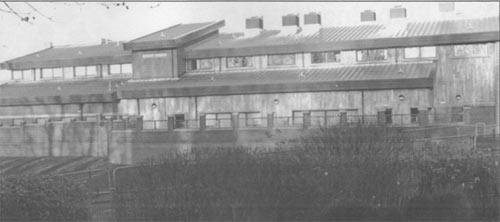 Perhaps the most striking aspect of the new Civic Centre is its lack of obvious connectivity. It stands alone and is slightly self-effacing. It forms part of the parkland rather than the town proper. With the exception of an off-set etched glass window there is little in the way of architectural embellishment that might give it a more exciting personality. This is perhaps a sign of an anxious future.
Perhaps the most striking aspect of the new Civic Centre is its lack of obvious connectivity. It stands alone and is slightly self-effacing. It forms part of the parkland rather than the town proper. With the exception of an off-set etched glass window there is little in the way of architectural embellishment that might give it a more exciting personality. This is perhaps a sign of an anxious future.
The external building materials are reasonably attractive. It is a shame that the Portland stone promised in the original proposals has been downgraded to artificial blocks but with the red brick panels the basic articulation of the exterior is created. One hesitates to say that they are complemented by turquoise cladding (“pre-patinated copper”!?) and vertical timber boards. The rustic boarding is a nod towards the sustainability agenda but it somehow feels misplaced as a focal building for an urban area of 30,000 people. In contrast the steel sheeting and service cowls on the roof lend a slightly industrial feel. The artificial Bath stone has been employed in a minimalist, post-modern way. 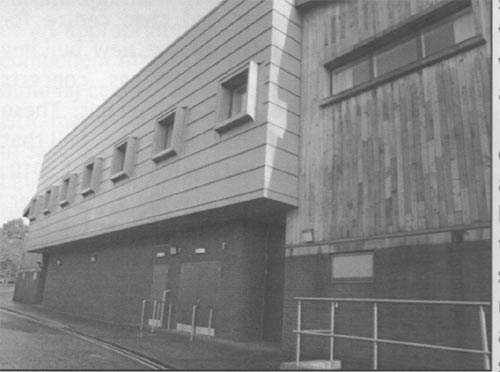 At the main entrance it is not visually tied back to the building; it seems to hover over the doorway as a thin veneer. One cannot help wondering how it will weather in the absence of traditional copings or a projecting cornice.
At the main entrance it is not visually tied back to the building; it seems to hover over the doorway as a thin veneer. One cannot help wondering how it will weather in the absence of traditional copings or a projecting cornice.
On the east front there is a second principal entrance primarily reserved for the main hall and conference facilities. The south side of the building gives a slightly tiered impression. Here there are practically no architectural pretensions but an effort has been made to make the most of the sunniest aspect by the provision of an external terrace. The users of the café should be able to spill out onto the patio that faces the mighty River Biss during the warmer months. At the time of making these notes, final landscaping remains to be completed.
Internally, the main space, which can accommodate up to 700 persons, has been named the Lansdown Hall. The centre may lack a grand staircase to the upper floor (or “piano nobile” as the architect called it!) but the main spaces, if not the first floor corridors, are friendly and welcoming. The council chamber, and adjacent traditional committee room, should be ideal to fill the vacuum created by the demise of the former District Council offices.
The overall design of the re-branded building is difficult to categorise. It seems harsh to declare that it is more school gymnasium than a grand civic building. In truth it seems a shame that such a major investment has lacked design ambition. However, the intention was clearly not to provide an architectural tour de force. Rather, the success of this new addition to the town will be judged by the efficiency and sustainability of the range of new facilities on offer.
An inclusive assessment cannot be reached without information on the financial costs and benefits but the provision of the Civic Centre certainly confirms the park's role as a genuine ‘people's park’ and the Town Council have done remarkably well to deliver any substantial project in the current financial climate.
| Corporate members: | Coleman & Starkey Family Dental Practice, Timbrell Street. The Trowbridge Museum. |
More on Parish Registers |
Back in the autumn Steve Hobbs gave us a fascinating glimpse of the oddments that can be found in parish registers - based on his book, Gleanings from Wiltshire Parish Registers (published by the Wiltshire Record Society). I have spent a lot of time exploring parish registers, so I thought it might be useful to set his talk in context by outlining their history.
In the 1530s, Henry VIII felt snubbed by the Pope, who had refused to allow him to divorce Catherine of Aragon. That was a dangerous thing to do. The man who had previously been declared ‘Defender of the Faith’ decided that he had no faith in Papal authority, and declared himself the supreme head of the English church. He gave Thomas Cromwell the post of vicegerent, with more authority over the church than any layman has ever had, before or since. Cromwell issued two sets of injunctions, in 1536 and 1538, which outlawed traditional practices such as pilgrimages and the veneration of saints, and which introduced the Bible in English to all churches. Whilst initiating the English Reformation, these injunctions also introduced parish registers of baptisms, marriages and burials. These have been kept ever since. The official reason for registering these events was ‘to avoid disputes touching ages, titles or lineal descents’. Ownership of land was the basis of status in English society. The gentry and the aristocracy needed to be able to prove their title to the land they owned, which had been inherited from their ancestors. That proof, Cromwell, thought, could best be provided if a register of baptisms, marriages and burials was kept in every parish.
The common people were suspicious of Cromwell's motives. They were ‘in greate feer and mystrust’, suspecting that registration meant the imposition of taxes. Indeed, such suspicions were a contributory factor in the Pilgrimage of Grace. If taxation had been in Cromwell's mind, he shied away from the idea. For the first century of parish registers no duties were imposed. The common people were not, however, wrong. Registration did provide an opportunity for duties to be levied. Such levies were attempted on two different occasions, between 1694 and 1705, and between 1783 and 1794. On neither occasion did the duty raise the revenue expected. Indeed, after the repeal of the 1694 duty, an act of indemnity had to be passed in order to indemnify those clergy who had refused to collect the tax. Registration itself did, however, succeed, and continues to this day. Most sixteenth century registers were copied into parchment books after injunctions passed in 1598 and 1604. The intention was to preserve the information. Sadly, however, it meant that the old paper registers - which may have had a lot more information in them - were discarded. Very few now survive, although the parchment books which replaced them are sometimes still extant.
In these old registers, there was no set format of entry. Baptism entries could just give the name of the child and the father, or they could add much detail - for example, the mother's name, the father's status or occupation, the parents' residence. The detail given in marriage and burial entries could be equally sparse or detailed, depending on the whim of the clerk. Much greater uniformity in marriage entries was, however, introduced by Lord Hardwickes Marriage Act in 1753. Hardwicke was concerned primarily with the rapid growth of irregular and clandestine marriage. This was due to a disconnect between canon law and the common law. Originally, marriage had been a civil event, nothing to do with the church. If a couple declared their marriage in front of witnesses, that was good enough for the common law. However, in the medieval period, it became the custom for marriages to take pLace before clergy, at the church door. Canon Law required that banns should be called before a marriage on three successive Sundays, or that a marriage licence should be obtained from the bishop. In the late seventeenth and early eighteenth centuries, many found such requirements burdensome, especially since a common law marriage was perfectly valid. ConsequentLy, a variety of marriage centres sprang up where the authority of bishops did not run, and where the requirements of canon law could be evaded. In the 1740s, over half of London marriages took place in the exempt jurisdiction of the Fleet Prison. Hardwickes act of 1753 put a stop to this. It required all marriages to be conducted by an Anglican clergyman, after the calling of banns or the issue of a valid marriage licence. Jews and Quakers were exempt. Marriages had to be recorded on printed forms. Banns registers were also required.
The new format for marriage entries was obviously successful. Rose's act 1812 decreed that printed forms should also be used for baptism and burial entries. However, the industrial revolution, combined with the growth of nonconformity, led to the widespread failure of parents to bring their children for Anglican baptism. The value of baptismal registers as sources of information for proving the descent of property was therefore decreasing. That bothered the ruling elite. Consequently, in 1837, civil registration was introduced. Clergy retained the right to register marriages: their registers were simply copied for the General Register Office. The registration of births and deaths became purely a matter for registrars. Nevertheless, clergy continued to compile registers of baptisms, and of the burials which took place in their own churchyards and cemeteries. That continues to this day. The major development in the history of parish registers in the last century or so has been the way in which they have been made available to researchers. Many have been published, either in print or online; even more have been indexed. The great majority have been deposited in record offices. Currently, registers are being increasingly digitised for online databases. The parish registers produced as a result of Cromwell's injunctions are now essential sources not just for the genealogist, but also the local historian, and the demographer.
I have provided a more detailed account in my Parish registers: a history and guide, published by the Family History Partnership. This is available from me at samjraymond@btopenworld.com, price £5.95 + £1.00 p&p (or ask me at meetings).
Civic Society Student Awards |
Clarendon College
The Trowbridge Civic Society Award for History was presented by Margaret Howard to Maks Dolejsz on January 5th 2012. Maks came to the school from Poland with no English, yet gained excellent A leveL grades. He is now at Bath Spa University reading history and heritage. He not only did well academically but was also presented with another award for Service to the Community, having been outstanding in this respect.
St Augustine's Catholic College
The award was given to Helen Long.
Trowbridge Historical Buildings Committee |
This was formed in 2008, when West Wiltshire District Council ceased to exist. It was created by the Civic Society, with the agreement of the Town Council. Its purpose is to allocate grants for the repair and maintenance of buildings of historic or architectural interest in Trowbridge. The Committee normally meets twice a year and has two members from the Town Council, the Chairman and two other members of the Civic Society, the Conservation Officer, a technical advisor and a historical advisor. The constitution and criteria for the allocation of grants were agreed by the Town Council and Civic Society jointly. They allow for grants to be made, (normally for up to 40% of the lowest estimate), for work to be done to preserve or enhance Listed Buildings. Exceptionally a grant could be made for a building of special historic interest that is not on the Schedule of Listed Buildings.
For further details please contact Jim Denning (Technical Officer) - jimdenning@gmx.co.uk
| Welcome to the following new members: | Clare Little, Richard Bluer, David Feather, Mr & Mrs Terry Randall |
RECENT MEETINGS |
Gleanings from Wiltshire Parish Records by Steve Hobbs 11th October
Steve Hobbs has recently published a book with the above title for the Wiltshire Record Society. In his talk to about 30 members he explained how he had trawled through 2000 Wiltshire parish records noting the incidental comments, doodles, poems, aphorisms etc which had been written in the registers by vicars, churchwardens and parish clerks. His talk showed that although the births, marriages and deaths in these registers have been recorded and put on microfilm, partly for the benefit of those researching family history, especially by the Mormons who provided this service free of charge, no one had until now, made a systemic study of these other. With the help of photographs, Steve showed us many examples ranging from the sixteenth to the early nineteenth century. Sometimes there were comments about unusual weather, storms or droughts; in 1750 someone had pasted in a cure for the bite of a mad dog; there were seating plans for the pews of the church which illustrated the social standing of members of the congregation; and in Broughton Gifford there was a record of building work carried out on the rectory. The payment of tithes was recorded and in Westbury the vicar made extensive notes, not all of them complementary, about many of his parishioners.Other registers reflected the threat of invasion at the time of the Napoleonic Wars. The register for Winterslow includes a statistical record of men able to serve, with arms and equipment they could provide, livestock, crops, wagons and corn mills. The aim was to deny Napoleon's army access to vital provisions and equipment and could have led to all the livestock in Wiltshire, including nearly 500,000 sheep and 65,000 cattle, being herded to Beckhampton Down, between Devizes and Amesbury. Steve, on his journey across this part of the county, often finds himself imagining such a sight!
The village parishes had more insertions than urban ones, so that there was very little out of the ordinary in Trowbridge records, apart from a notation of bell ringing changes and “some verse”. At first glance some these gleanings may seem inconsequential, but in reality they can give fascinating insights into everyday life in Wiltshire which otherwise wouLd be lost to us.
The usual delicious refreshments were provided by Ruth Bridges.
PUBLIC LECTURE -The history of Trowbridge pubs by Ken Rogers 15 November 2011
This joint meeting with the Friends of the Trowbridge Museum, not surprisingly, attracted an excellent attendance of over 60 members, friends and guests.
The two major (coaching) inns were The George (the facade was saved by the action of the Society and now fronts Clarks shoe shop) and the Woolpack(s), now the site of of Knees main shop next to Boots opticians. There is evidence for a George tavern in 1349 and if still trading it would be among the half dozen oldest pubs in the country. Around the time of the French revolution a meeting of licensees suggests there were 22 pubs in the town. There are some still in existence, others survived in our time and many have come and gone in the meantime. The Horse and Groom in Back Street (the building is still there) was notorious for attracting “nymphs of the pavement”. In a remarkable piece of symmetry there are still 22 Trowbridge pubs - arguably. Our oldest pubs include The White Swan, Carpenters Arms, The Crown, Kings Arms in Castle Street and Hilperton Marsh and The Courthouse. In the 18th and 19th centuries a remarkable array of fairs, feasts and other entertainments were focussed on the two main coaching inns including recitals by Continental musicians, backsword competitions (break 2 or 3 heads to progress to the next round) and most bizarrely, pigeon shooting, NB. pigeons wanted!
Ken was in imperious form and enthralled us with his vast and scholarly knowledge, clarity of delivery and, at times, impish humour. Can any other town have a Ken Rogers? - surely not. After questions, a raffle run by Peter Bull, sale of museum yellow books and the latest volume (6) of Trowbridge History we enjoyed refreshments prepared by Ruth Bridges and the opportunity to meet new and old friends.
Trowbridge's history is to be scrolled out ... |
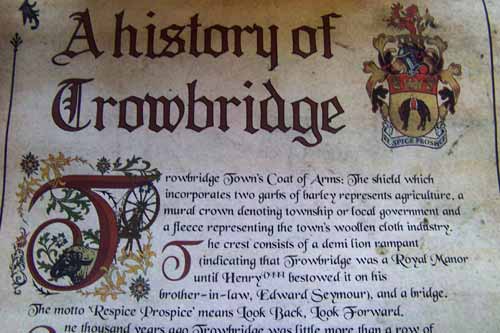 The Trowbridge Museum gets numerous enquiries from all over the world about Trowbridge's history and so this has prompted Museum staff and BML Ltd to produce a high quality printed scroll on parchment effect paper containing a précis of Trowbridge's long and fascinating history and development combined with an explanation of its unique crest.
The Trowbridge Museum gets numerous enquiries from all over the world about Trowbridge's history and so this has prompted Museum staff and BML Ltd to produce a high quality printed scroll on parchment effect paper containing a précis of Trowbridge's long and fascinating history and development combined with an explanation of its unique crest.
The scrolls are bound in ribbon and will make the perfect gift for history buffs, friends and family. They are on sale at the Museum and on its new website, Trowbridge Information Centre, Waterstones and Pitts and retail at £6.99. There will be an additional charge for postage and packing.
An Affront to Trowbridge |
Look around Trowbridge town centre carefully. How many shop fronts do you see which do not detract from the charm of the old buildings behind and around them? Not too many, i'll be bound. W H Smiths, Clark’s Shoes, Weatherspoons and the banks are some of the few exceptions. For too long Trowbridge has suffered from second-class development. It has effectively been a second class town for far too long. Surely we want better? Our Councils need to do better. Our historic buildings deserve better.
Just examine the standard of shop fronts we have to suffer. I think that the new “Cash Generator” shop in Fore Street opposite the old Boots (Photo 1) is a horror. As for McColl's (Photo 2), what can one say? Its saving grace is that there is a bus shelter in front of it and it is often hidden from view by a bus. It is a very busy footway, yet we have to negotiate the refuse bins outside the shop as well as suffer the poor shop front.
Is there not a better way? Wiltshire Council has placed considerabLe emphasis on the need for a high standard of urban design. Its Core Strategic Objective 6 is “to safeguard and promote a high quality built and historic environment”. West Wiltshire District Council set out policies in its Local Plan to deal with shop fronts. All this is commendable but if it is not enthusiastically pursued we have the present situation.
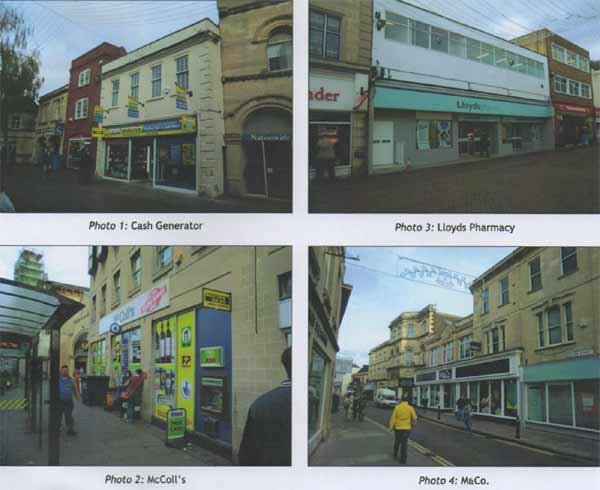 It is possible to achieve stronger control of the design of shop fronts by establishing an “Area of Special Control of Advertisements”. The old Salisbury District Council had done this and produced guidelines for Salisbury and it looks as if these have been adopted by Wiltshire Council. Could not the Planning Authority now work with Trowbridge Town Council, the Civic Society and TCAF to produce similarly good guidelines for shop front design based around a “Special Area” and conservation area designation for Trowbridge centre? Surely shrewd developers and property owners must see the potential in the town centre and should welcome such a move?
It is possible to achieve stronger control of the design of shop fronts by establishing an “Area of Special Control of Advertisements”. The old Salisbury District Council had done this and produced guidelines for Salisbury and it looks as if these have been adopted by Wiltshire Council. Could not the Planning Authority now work with Trowbridge Town Council, the Civic Society and TCAF to produce similarly good guidelines for shop front design based around a “Special Area” and conservation area designation for Trowbridge centre? Surely shrewd developers and property owners must see the potential in the town centre and should welcome such a move?
Two big developers seem to think so with the investment going into the Crushmore and Bowyers sites. If we have widespread better design it is a win-win situation. The town will attract more people into the centre and the shops and other commercial activities will thrive.
What sort of things could be done to improve matters in the short term? In my view Lloyds Pharmacy (Photo 3) has shown one way by its use of a more restrained colour scheme than that of the Boots frontage. It still retains the wide horizontal frontage, unfortunately. One could also improve the front of the Post Office by planting a tree or three there. We lack some greenery in that part of the town anyway. It could be made a pleasant place to sit.
According to the Local Plan policies, when a shop front is being considered, the design should reflect the historic building behind it. M&Co in Silver Street (Photo 4) has a nice restrained black and white scheme, but unfortunately it does not relate to the stone building frontages above it. Clearly some difficult design problems would be involved in situations like this but they should not be insurmountable. Salisbury has shown the way. It should be easier now for Trowbridge to follow.
The views expressed in this article are those of the author, who is not an architect or town planner, but who does want to see a more attractive town centre, something more appropriate for such an historic town.
Trowbridge Roofs |
Can you identify them all? Answers at the next Civic Society meeting and in the next newsletter
